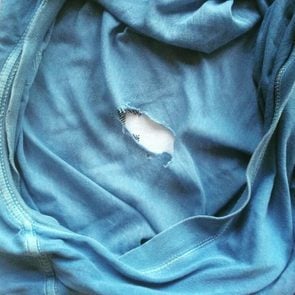How to Recycle Old Clothes According to Experts
Updated: Apr. 17, 2024

Not all closet castoffs are destined for the dump. Try these Earth-friendly alternatives to tossing old clothes and other textiles, so they don't end up in a landfill.
Wondering what to do with old clothes? Before tossing them in the trash, consider clothes recycling. Otherwise, your outdated and discarded wardrobe could end up like the 22 million tons of microfibers that are expected to be added to the ocean by the textiles industry between 2015 and 2050.
Why recycling clothes is better for the environment than throwing them away
There are many ways to recycle clothes, depending on their condition, from donating to composting to upcycling. Throwing clothes away should be the last resort, according to experts. “Landfills are essentially tombs for waste,” says Lauren Olson, zero waste manager at WorldCentric. “Anything you can do to avoid landfilling an item and otherwise recycle or compost it will help.”
Not only do landfills release harmful greenhouse gases that contribute to global warming, but they can also pollute the local land, water, and air with hazardous chemicals. Who knew that simply throwing out your unwanted items could do such damage—or that such a simple change could help the environment so much?
How can old clothes be recycled?
Try these clothes recycling tips to breathe new life into your old garb and do your part for the Earth. After learning how to organize a closet, how to clean a closet like a professional organizer, and how to recycle anything, try refreshing your style with timeless, high-quality pieces to cut down on textile waste and create a capsule wardrobe from the best sustainable fashion brands.
Donating
Donating old garments to charity thrift stores near you, such as Goodwill and The Salvation Army, might be the most obvious clothes recycling option. These nonprofit organizations will resell your gently used clothing to support programming for underprivileged communities. Anything they can’t sell at store locations will be taken to local textile recycling centers, Olson says. In addition to helping those in need and reducing waste, you’ll get a tax deduction if you get a receipt for your donations.
If you have old jeans, Cotton’s Blue Jeans Go Green recycling initiative is great for donating denim specifically. As long as the jeans are 90 percent cotton, you can mail them your old denim to be turned into creative new products, like insulating material, pet bed inserts, or thermal insulation used in sustainable food and pharmaceutical packaging.
Animal shelters also often accept old towels and sheets, which are used to line pet cages, dry off wet dogs, and more. When your spring cleaning kicks into high gear, check out these small closet ideas for a less cluttered space.
Selling
Make a quick buck (and save the planet!) by selling your gently used clothes at brick-and-mortar thrift stores or the best places to sell clothes or old stuff online.
Some of your favorite retailers will pay you to take old items off your hands too. Patagonia’s Worn Wear program collects gently used Patagonia gear in exchange for store credit, and DSW will take your old shoes in exchange for points toward your next purchase. Trade your “pre-loved” pants for $20 off a new pair through Madewell’s Do Well recycling initiative, or bring in a bag of unwanted clothing to H&M for 15 percent off your next purchase.
Many of these programs resell items in good condition and recycle the rest into new materials, such as housing insulation for low-income communities. You could find a few things to sell in your coat closet, especially after doing some coat closet organization and decluttering.
Textile recycling
While clothes don’t belong in recycling bins, they can be recycled in other ways. Textile recycling centers accept and sort garments that are not in good enough condition to donate or sell, like stained and torn items. Many of these donations are sold abroad to regions such as Africa or Asia, where small entrepreneurs resell the clothing, according to Olson.
To find out where to recycle clothes in your area, websites like Earth911 and Recycle Now offer searches by zip code. No textile recycling location near you? The American Textile Recycling Service may have a drop-off bin in your area. Olson also suggests asking your local curbside recycler if they offer occasional clothes recycling services like Simple Recycling.
Composting
Believe it or not, clothes and other textiles make great composting material! Look for natural fiber items made of pure wool, cotton, silk, or linen that are too old or damaged to donate, and cut them into small pieces to speed up the composting process.
Before adding the material to your compost pile, make sure to remove all plastic buttons, metal zippers, or stains from non-compostable substances like motor oil and paint. You can also check with your city to see if they accept clothing for composting. If your city doesn’t compost clothes, here is everything you need to know about how to make compost at home.
Repurposing
Your no-longer-needed garb may have seen better days, but it can still have a second life in your home. A favorite, worn-out shirt or sweater can become a pillow cover, or you can turn old blankets and flannel sheets into a pet bed. Olson suggests using damaged T-shirts and towels as reusable dusting or cleaning cloths, rather than disposable paper towels, to cut down on paper waste. You can also make a quilt or DIY face mask out of cast-off T-shirts, pajamas, and other materials, she says.
Now that your old towels and sheets aren’t cluttering up your closets, try these utility closet organizing tips for a truly streamlined space.
Sources:
- Ellen MacArthur Foundation: “A new textiles economy: Redesigning fashion’s future”
- Lauren Olson, zero waste manager at WorldCentric
- Evironmental Protection Agency: “Report on the Environment: Wastes”





















